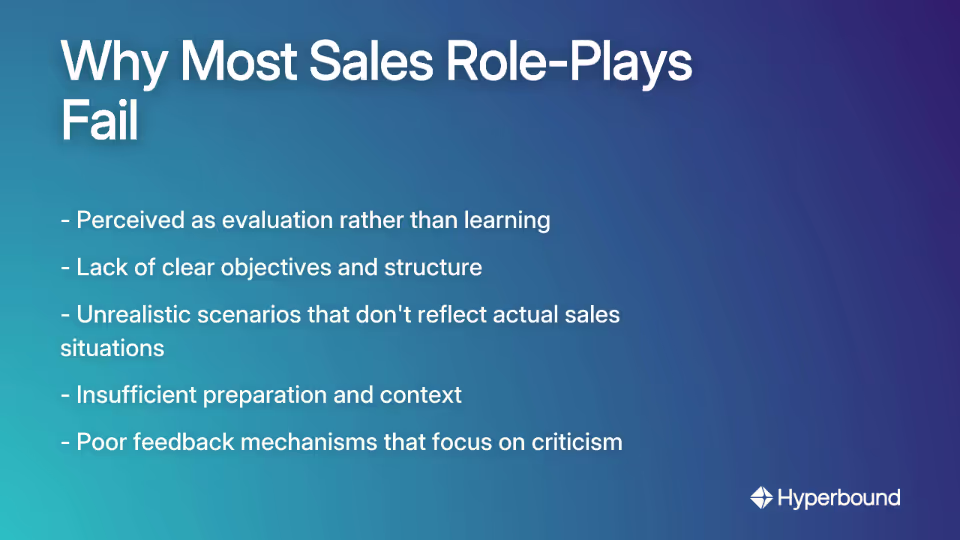
You've been there before. You announce a sales role-play session, and the room immediately fills with groans, eye-rolls, and that unmistakable look of dread. One rep mumbles something about "awkward busy work," while another suddenly discovers an urgent client email that needs immediate attention.
"Role playing sucks and I'm terrible at it but I can rip any sales call easy." Sound familiar?
The truth is, most sales role-plays (RPs) fail spectacularly. They create artificial scenarios where "yes, of course I will take this cold call. And wow, my problem aligns EXACTLY with your solution" – leaving your team feeling judged, uncomfortable, and convinced they're wasting valuable selling time.
But here's the thing: when structured correctly, role-play isn't just a valuable training tool – it's arguably the most powerful weapon in your B2B sales coaching arsenal. The difference between role-plays that feel like painful busy work and those that transform performance comes down to structure, psychology, and execution.
This guide will show you exactly how to create role-play experiences that your team actually values and that deliver measurable improvements in discovery calls, objection handling, and overall sales performance.
The Foundation: Shifting the Mindset
The first step in effective role-play is addressing the fundamental psychology behind why most sessions fail.

From Test to Training Ground
The primary goal of role-play isn't to test or evaluate performance – it's to create a safe coaching environment. It’s a well-established principle that the most successful sales enablement teams never use role-play to berate or criticize salespeople.
Your reps already feel like "the RP is much more uncomfortable, probably because you know everyone in the room is judging your performance and knows every time you slip up or leave something out." This heightened pressure is precisely what makes role-play feel "10x harder than actual sales calls" for many team members.
To counter this:
- Explicitly state the purpose: Begin every session by reminding everyone that this is a training ground, not a performance evaluation.
- Lead by example: Managers should participate first, making deliberate mistakes to demonstrate that imperfection is expected and valuable.
- Establish ground rules: No interrupting, no negative language, and a commitment to constructive feedback only.
Set Crystal-Clear Objectives
Vague objectives lead to vague results. Before any role-play session, define the specific skill or situation to be practiced.
You must clearly define: Are you working on the elevator pitch? A specific part of the discovery call? Handling the price objection during prospecting?
This structured approach appeals to sales professionals who "learn optimally when following a structured routine" and are looking for effective training pathways rather than scattered techniques.
The 4-Step Structure for High-Impact Role-Play Sessions

Step 1: Preparation is Everything
The most effective role-plays begin long before anyone starts speaking. Most managers skip this critical phase, which explains why their sessions feel artificial and unhelpful.
Start with Customer Research: Don't invent scenarios in a vacuum. Use real-world data from:
- Recorded sales calls (both successful and unsuccessful)
- Customer interviews about their buying process
- Common objections documented by your sales team
Advanced platforms like Hyperbound can even analyze your top reps' call recordings to automatically create role-play scenarios based on winning behaviors.
This preparation addresses the complaint that during role-plays "nothing is genuine... you are not actually selling anything, nothing you say will actually sway the other person's mind." By grounding scenarios in reality, you make them immediately more relevant.
Develop Realistic Scenarios: Create scenario cards that include:
- Prospect company background
- Buyer persona details (role, priorities, pain points)
- Specific situation (first cold call, discovery, objection handling)
- Contextual constraints (time limit, budget concerns, competitive situation)
For example, instead of "Practice a discovery call," provide: "You're speaking with a VP of Marketing at a mid-size SaaS company who's expressed interest but is currently using a competitor. They have concerns about implementation time and ROI. Your goal is to conduct effective discovery to uncover their true priorities."
Step 2: Execution - Running the Role-Play
With solid preparation in place, focus on execution that maximizes learning while minimizing discomfort.
Assign Roles Strategically: Have participants play both seller (the Account Executive) and buyer roles. Rotating roles allows team members to experience both sides of the conversation, building empathy and understanding of the customer's perspective.
Keep it Focused and Brief: The most effective B2B sales role-plays are short and targeted. If you're practicing objection handling, don't run through an entire discovery call first. Jump directly to the objection scenario and limit sessions to 5-7 minutes.
Record When Possible: Recording mock calls removes the pressure of having to both participate and remember feedback. It also allows participants to hear themselves, often revealing patterns they weren't aware of. AI-powered tools like Hyperbound's AI Sales Roleplays take this a step further, providing a safe, scalable environment for reps to practice on-demand with an AI buyer that provides instant, objective feedback.
Step 3: The Debrief - Mastering Constructive Feedback
This is where the real learning happens. Never skip the feedback session.
Start with Self-Reflection: Before anyone else speaks, ask the person who played the AE: "What do you think went well? What would you change next time?" This encourages ownership of development and often reveals they already know what needs improvement.
Use the 2:1 Positive Ratio: For every improvement area, highlight two things that were done effectively. This balanced approach builds confidence while still driving skill development.
Be Specific and Actionable: Avoid vague feedback like "your discovery questions need work." Instead, offer precise alternatives: "I noticed you asked three closed-ended questions in a row. Try replacing 'Do you have budget concerns?' with 'What factors will influence your budget decision?'"
Focus on Behavior, Not the Person: Never say "You seemed nervous" or "You're not confident enough." Instead, focus on observable behaviors: "Speaking more slowly during the objection response would give you more authority."
Step 4: Reinforce and Repeat
The real power of role-play comes from consistency and reinforcement.
Identify Key Takeaways: At the end of each session, have participants articulate 1-2 specific techniques they'll apply in their next real sales call.
Make it Regular: One-off sessions don't create lasting change. Effective role-play should be integrated into your weekly or bi-weekly sales meetings as a standard practice.
Build a Progressive Curriculum: Start with basic skills and gradually increase complexity. For new reps, begin with simple cold call openings before moving to complex objection handling scenarios.
8 Must-Try Role-Play Scenarios That Actually Develop Skills
Here's a menu of targeted role-play scenarios directly linked to the specific skills they develop. Each addresses real-world challenges your team faces every day.
1. The Discovery Call Mastery
Skill Focus: Asking effective probing questions and identifying buyer problemsScenario: An interested prospect has agreed to a 30-minute discovery call after downloading a whitepaper. They're aware of your solution but skeptical about its relevance to their specific challenges.Key Challenge: Resist the urge to pitch prematurely and instead focus on uncovering the prospect's underlying pain points.
This is particularly valuable for new reps who tend to talk more than listen during initial calls. As one sales professional noted, "If you're practicing discovery, that's a good use case for a mock call."
2. The Cold Call Opener
Skill Focus: Capturing attention in the first 30 secondsScenario: You're cold calling a VP-level decision maker who's likely in the middle of something else. You need to quickly establish relevance and earn another few minutes of conversation.Key Challenge: Craft an opener that addresses a specific pain point without sounding generic or scripted.
This role-play directly addresses the challenge of prospecting by helping reps practice thinking on their feet when facing typical initial resistance.
3. The Price Objection Defense
Skill Focus: Maintaining value during pricing discussionsScenario: A qualified prospect responds to your proposal with: "This looks good, but honestly, your competitor is offering something similar for 20% less."Key Challenge: Redirect the conversation to value rather than getting dragged into a price-only discussion.
Objection handling practice is consistently rated as one of the most valuable uses of role-play by experienced sales professionals, especially when using verbatim objections from real prospects.
4. The Competitive Battle
Skill Focus: Positioning against specific competitorsScenario: Midway through your sales process, the prospect mentions they're also evaluating your primary competitor and asks you to explain the differences.Key Challenge: Highlight your differentiators without disparaging the competition or appearing defensive.
This scenario helps reps prepare for one of the most challenging moments in B2B sales cycles – when prospects directly ask for competitive comparisons.
5. The Multi-Stakeholder Navigation
Skill Focus: Managing different priorities across a buying committeeScenario: You're in a meeting with three stakeholders: the user (focused on features), the technical implementer (concerned about integration), and the financial buyer (focused on ROI).Key Challenge: Address each stakeholder's concerns while maintaining a cohesive narrative about your solution's value.
This complex scenario helps prepare reps for the reality of enterprise sales where single-stakeholder decisions are increasingly rare.
6. The Sales Interview Simulation
Skill Focus: Demonstrating sales acumen during hiring processesScenario: For new hire training or internal promotions, simulate a typical sales interview where candidates must pitch your product to a "hiring manager."Key Challenge: Show both product knowledge and sales methodology in a pressure situation.
This scenario serves double duty – helping potential new hires prepare for interviews while reinforcing core selling skills.
7. The Executive Conversation
Skill Focus: Communicating with C-suite decision makersScenario: You've secured a 15-minute call with the CEO after months of working with lower-level stakeholders. You need to quickly establish credibility and business relevance.Key Challenge: Elevate the conversation from features to strategic business outcomes.
This role-play helps bridge the gap between product-level discussions and executive-level value conversations that close deals.
8. The Negotiation Finale
Skill Focus: Protecting margins during final negotiationsScenario: The prospect has verbally committed but is asking for last-minute concessions before signing.Key Challenge: Find creative solutions that maintain deal value while giving the prospect a win.
This scenario prepares reps for the delicate final stages where deals are often won or lost.
From Awkward Exercise to Essential Tool
Effective role-play isn't about performance; it's about preparation. When structured correctly, it transforms from a dreaded task into one of the most powerful tools in your sales enablement toolkit.
The key is creating a psychologically safe environment where your team can practice specific skills with clear objectives and receive constructive feedback. By using realistic scenarios drawn from actual customer interactions, you make role-play relevant rather than artificial.
As your team becomes more comfortable with regular role-play sessions, you'll see measurable improvements in their discovery calls, objection handling, and overall sales effectiveness. The awkward silences and eye-rolls will gradually be replaced by engaged participation and improved results.
Start small – pick just one specific scenario from the list above for your next team meeting. Focus on creating that safe environment with constructive, actionable feedback. Your team might not immediately thank you, but their improved performance and confidence on real sales calls certainly will.
Frequently Asked Questions
What is the primary purpose of sales role-play?
The primary purpose of sales role-play is to provide a safe and structured training environment for sales representatives to practice specific skills, not to test or evaluate their performance. It's a coaching tool designed to build confidence and refine techniques in a low-stakes setting before they engage with actual prospects.
How can I make sales role-play less awkward for my team?
To make role-play less awkward, focus on creating psychological safety. Start by explicitly stating that the session is for practice, not judgment. Managers should participate and even make deliberate mistakes to show vulnerability. Also, establish clear ground rules, such as no interruptions and a commitment to purely constructive feedback.
What makes a sales role-play scenario effective?
An effective sales role-play scenario is realistic and specific, directly mirroring challenges your team faces. Instead of generic prompts, use data from real sales calls, customer interviews, and documented objections to build your scenarios. Include details like buyer persona, company background, and specific contextual challenges to make the practice relevant and engaging.
How often should a sales team do role-play?
For best results, sales teams should conduct role-play sessions regularly, making it a consistent part of their training rhythm. Integrating short, focused role-plays (10-15 minutes) into weekly or bi-weekly sales meetings is an effective approach. Consistency is more important than length; frequent, brief practice builds skills more effectively than occasional, long sessions.
Who should participate in a sales role-play session?
Everyone on the team should participate, including sales managers. Participants should rotate between playing the seller (Account Executive) and the buyer. This rotation builds empathy and gives reps a deeper understanding of the customer's perspective. Managers participating first helps set a positive, low-pressure tone for the session.
How do you give constructive feedback after a role-play?
Effective feedback starts with self-reflection, asking the participant what they thought went well and what they'd change. Follow this with specific, actionable advice using a 2:1 positive-to-constructive ratio. Focus on observable behaviors (e.g., "Try asking an open-ended question here") rather than personal traits (e.g., "You seemed nervous").
What are good role-play scenarios for new sales reps?
For new reps, start with foundational and less complex scenarios. Good starting points include the "Cold Call Opener" to practice capturing attention in the first 30 seconds, or a simple "Discovery Call" focused on asking 3-4 key qualifying questions. As they build confidence, you can gradually introduce more complex situations like handling initial price objections or competitive questions.
How can AI improve sales role-play?
AI can significantly improve sales role-play by providing a scalable, on-demand practice environment. AI-powered tools like Hyperbound offer a non-judgmental "buyer" for reps to practice with anytime, removing the scheduling constraints and social pressure of group sessions. These platforms can also provide instant, objective feedback on performance, helping reps iterate and improve much faster.

Book a demo with Hyperbound
.png)













